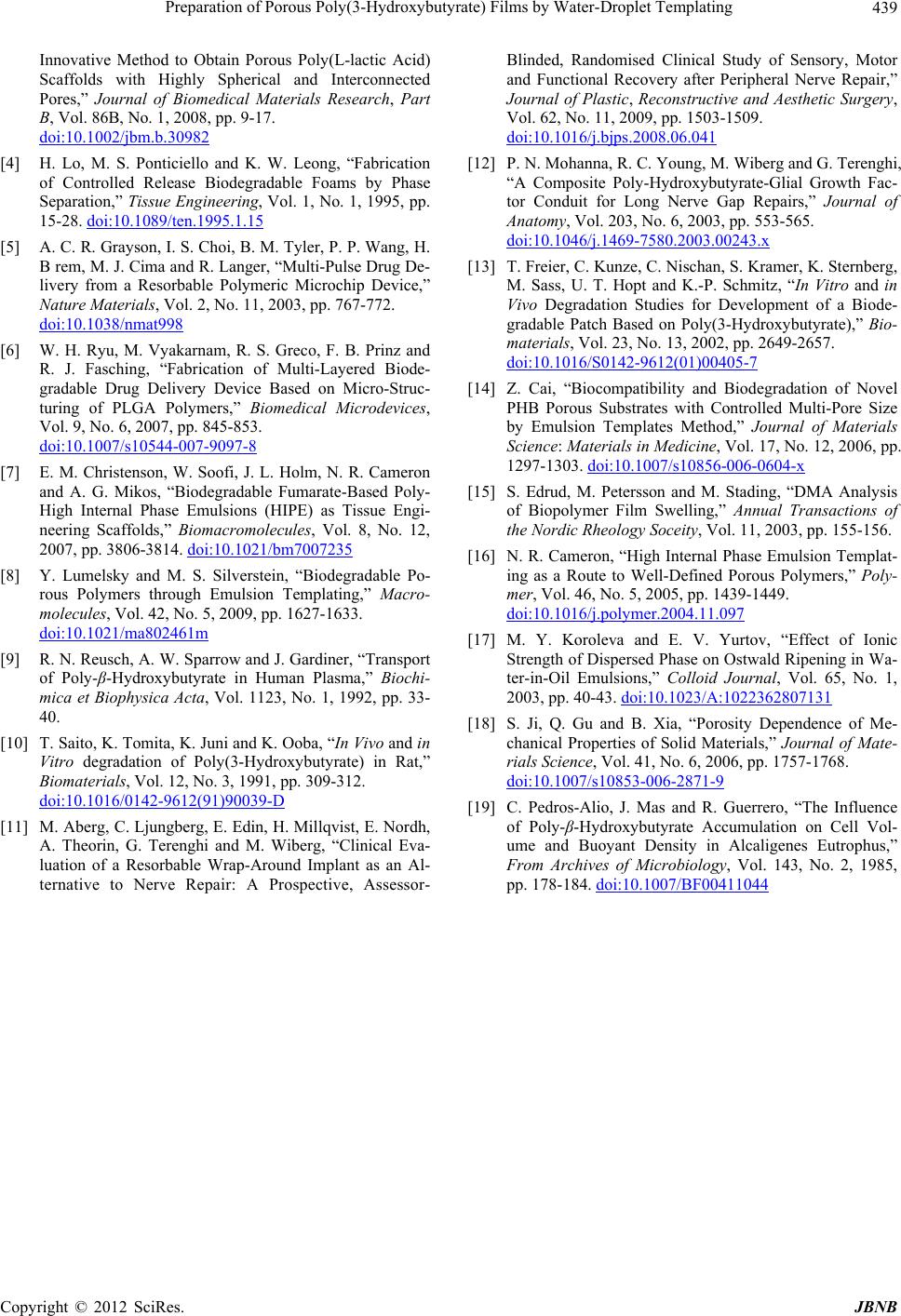
Preparation of Porous Poly(3-Hydroxybutyrate) Films by Water-Droplet Templating
Copyright © 2012 SciRes. JBNB
439
Innovative Method to Obtain Porous Poly(L-lactic Acid)
Scaffolds with Highly Spherical and Interconnected
Pores,” Journal of Biomedical Materials Research, Part
B, Vol. 86B, No. 1, 2008, pp. 9-17.
doi:10.1002/jbm.b.30982
[4] H. Lo, M. S. Ponticiello and K. W. Leong, “Fabrication
of Controlled Release Biodegradable Foams by Phase
Separation,” Tissue Engineering, Vol. 1, No. 1, 1995, pp.
15-28. doi:10.1089/ten.1995.1.15
[5] A. C. R. Grayson, I. S. Choi, B. M. Tyler, P. P. Wang, H.
B rem, M. J. Cima and R. Langer, “Multi-Pulse Drug De-
livery from a Resorbable Polymeric Microchip Device,”
Nature Materials, Vol. 2, No. 11, 2003, pp. 767-772.
doi:10.1038/nmat998
[6] W. H. Ryu, M. Vyakarnam, R. S. Greco, F. B. Prinz and
R. J. Fasching, “Fabrication of Multi-Layered Biode-
gradable Drug Delivery Device Based on Micro-Struc-
turing of PLGA Polymers,” Biomedical Microdevices,
Vol. 9, No. 6, 2007, pp. 845-853.
doi:10.1007/s10544-007-9097-8
[7] E. M. Christenson, W. Soofi, J. L. Holm, N. R. Cameron
and A. G. Mikos, “Biodegradable Fumarate-Based Poly-
High Internal Phase Emulsions (HIPE) as Tissue Engi-
neering Scaffolds,” Biomacromolecules, Vol. 8, No. 12,
2007, pp. 3806-3814. doi:10.1021/bm7007235
[8] Y. Lumelsky and M. S. Silverstein, “Biodegradable Po-
rous Polymers through Emulsion Templating,” Macro-
molecules, Vol. 42, No. 5, 2009, pp. 1627-1633.
doi:10.1021/ma802461m
[9] R. N. Reusch, A. W. Sparrow and J. Gardiner, “Transport
of Poly-β-Hydroxybutyrate in Human Plasma,” Biochi-
mica et Biophysica Acta, Vol. 1123, No. 1, 1992, pp. 33-
40.
[10] T. Saito, K. Tomita, K. Juni and K. Ooba, “In Vivo and in
Vitro degradation of Poly(3-Hydroxybutyrate) in Rat,”
Biomaterials, Vol. 12, No. 3, 1991, pp. 309-312.
doi:10.1016/0142-9612(91)90039-D
[11] M. Aberg, C. Ljungberg, E. Edin, H. Millqvist, E. Nordh,
A. Theorin, G. Terenghi and M. Wiberg, “Clinical Eva-
luation of a Resorbable Wrap-Around Implant as an Al-
ternative to Nerve Repair: A Prospective, Assessor-
Blinded, Randomised Clinical Study of Sensory, Motor
and Functional Recovery after Peripheral Nerve Repair,”
Journal of Plastic, Reconstructive and Aesthetic Surgery,
Vol. 62, No. 11, 2009, pp. 1503-1509.
doi:10.1016/j.bjps.2008.06.041
[12] P. N. Mohanna, R. C. Young, M. Wiberg and G. Terenghi,
“A Composite Poly-Hydroxybutyrate-Glial Growth Fac-
tor Conduit for Long Nerve Gap Repairs,” Journal of
Anatomy, Vol. 203, No. 6, 2003, pp. 553-565.
doi:10.1046/j.1469-7580.2003.00243.x
[13] T. Freier, C. Kunze, C. Nischan, S. Kramer, K. Sternberg,
M. Sass, U. T. Hopt and K.-P. Schmitz, “In Vitro and in
Vivo Degradation Studies for Development of a Biode-
gradable Patch Based on Poly(3-Hydroxybutyrate),” Bio-
materials, Vol. 23, No. 13, 2002, pp. 2649-2657.
doi:10.1016/S0142-9612(01)00405-7
[14] Z. Cai, “Biocompatibility and Biodegradation of Novel
PHB Porous Substrates with Controlled Multi-Pore Size
by Emulsion Templates Method,” Journal of Materials
Science: Materials in Medicine, Vol. 17, No. 12, 2006, pp.
1297-1303. doi:10.1007/s10856-006-0604-x
[15] S. Edrud, M. Petersson and M. Stading, “DMA Analysis
of Biopolymer Film Swelling,” Annual Transactions of
the Nordic Rheology Soceity, Vol. 11, 2003, pp. 155-156.
[16] N. R. Cameron, “High Internal Phase Emulsion Templat-
ing as a Route to Well-Defined Porous Polymers,” Poly-
mer, Vol. 46, No. 5, 2005, pp. 1439-1449.
doi:10.1016/j.polymer.2004.11.097
[17] M. Y. Koroleva and E. V. Yurtov, “Effect of Ionic
Strength of Dispersed Phase on Ostwald Ripening in Wa-
ter-in-Oil Emulsions,” Colloid Journal, Vol. 65, No. 1,
2003, pp. 40-43. doi:10.1023/A:1022362807131
[18] S. Ji, Q. Gu and B. Xia, “Porosity Dependence of Me-
chanical Properties of Solid Materials,” Journal of Mate-
rials Science, Vol. 41, No. 6, 2006, pp. 1757-1768.
doi:10.1007/s10853-006-2871-9
[19] C. Pedros-Alio, J. Mas and R. Guerrero, “The Influence
of Poly-β-Hydroxybutyrate Accumulation on Cell Vol-
ume and Buoyant Density in Alcaligenes Eutrophus,”
From Archives of Microbiology, Vol. 143, No. 2, 1985,
pp. 178-184. doi:10.1007/BF00411044